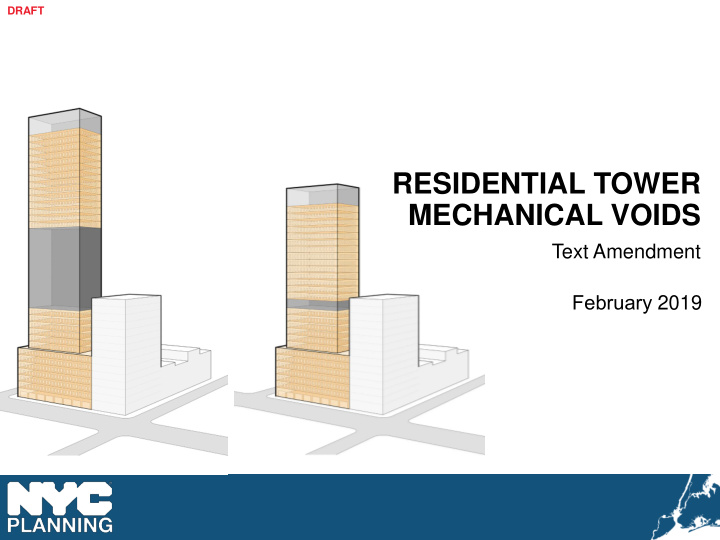



DRAFT RESIDENTIAL TOWER MECHANICAL VOIDS Text Amendment February 2019
Introduction – What is a “Mechanical Void”? • NYC Zoning Resolution allows mechanical floor spaces to be excluded from zoning floor area calculations. There are no explicit height limits on these spaces. • In recent years, some developments utilized excessively tall mechanical floors so that upper-story residential units are located above the surrounding context. • Known as a “mechanical void” • Mayor de Blasio asked DCP to examine the issue of excessive mechanical voids and provide a recommendation. • DCP conducted a citywide analysis of recent construction to better understand the mechanical needs of residential buildings and to assess where and when excessive mechanical spaces are being used. DRAFT 2
A Typical Tower 281 Fifth Avenue, MN (under construction) / C5-2 District A typical tower has: • A mechanical floor at a lower level, typically in between non-residential floors and residential floors • Taller towers typically have an additional mechanical floor every 20 stories or so • A larger mechanical bulkhead on the top DRAFT 3
Proposal: What We Would Address Excessively large, contiguous or clustered, residential mechanical voids in towers Contiguous voids in middle section Contiguous voids in lower section Cluster of voids in lower section Tower on a Base Standard Tower Standard Tower DRAFT 4
Proposal: Our Goals • Limit the use of artificially tall residential mechanical voids • Encourage residential buildings that activate and engage with their surroundings • Recognize the need for reasonably sized and distributed mechanical spaces in residential buildings • Continue to support the bulk flexibility for design excellence DRAFT 5
Proposal: Basic Rule • Modify residential tower floor area provisions in ZR 23-16 to count mechanical voids that Proposal would not regulate mechanical exceed the height of 25 feet as penthouse “zoning floor area” • Mechanical penthouses above the highest residential floor would not be subject to this regulation 3 stories/ 132 feet mechanical If a mechanical void is 132 feet in void height, that space would count as 5 floors of “zoning floor area” (132’ / 25’ = 5.28, rounded to 5) DRAFT 6
Proposal: Clustering If any mechanical floors are located within 75' of each other Mechanical they would all count as “zoning penthouses above the highest floor area,” regardless of the residential floor height of each floor A cluster of mechanical floors which total 80 feet would count as 3 floors of “zoning floor area,” even when each floor is less than 25 feet and Reasonably sized and distributed noncontiguous mechanical space (80’ / 25’ = 3.2 rounded to 3) Cluster of 20’ mechanical floors that totals 80’. DRAFT 7
Proposal: Residential Voids v. Non-residential Voids For mixed-use buildings, non- residential mechanical spaces would also be subject to the same “25 -foot/75- foot rule,” if non-residential floor space occupies less than 25% of a building DRAFT 8
Proposal: Residential Voids v. Non-residential Voids For mixed-use buildings with substantial amount of non- residential floor space (i.e. more than 25%), non- residential mechanical voids would not be subject to this proposal. Mt. Sinai Medical School / residential tower on the right has three floors of mechanical spaces in the middle: two floors for medical use and one floor for residential use. DRAFT 9
Proposal: Text Amendment Summary • Modify residential tower floor area provisions (ZR 23-16) to count mechanical voids that are taller than 25 feet as “zoning floor area” • Mechanical voids located within 75 feet of each other to count as “zoning floor area,” regardless of the height of each floor • Non-residential mechanical spaces in mixed-use buildings to be subject to the same “25 -foot/75- foot rule,” if non -residential uses occupy less than 25% of a building DRAFT 10
Proposal: Text Amendment Summary Excessive Reasonably-sized mechanical space mechanical space No Action With Action DRAFT 11
Proposal: Where These Regulations Would Apply • Residential tower developments located within non-contextual R10 and R9 Districts and their equivalent Commercial Districts • Special Districts that rely on the underlying FAR and tower height regulations • The proposal would also include portions of Special Districts that impose special tower regulations DRAFT 12
Recommend
More recommend